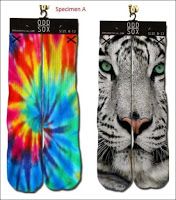The TTAB affirmed a refusal to register the packaging design shown below, for "socks," finding the design to be generic for the goods because consumers would primarily regard the design as a common type of packaging rather than as a source indicator. The Board also considered and rejected Applicant Odd Sox's alternative claim of inherent distinctiveness. (Odd Sox did not contend that the design had acquired distinctiveness.) In re Odd Sox LLC, 2019 USPQ2d 370879 (TTAB 2019) [precedential] (Opinion by Judge Karen Kuhlke).

The subject application described the alleged mark as a "three-dimensional configuration of product packaging for displaying a single pair of socks hanging side by side." The socks, two fasteners, and the hook are shown in dashed lines and are not part of the mark.
Genericness: The CAFC in Sunrise Jewelry Mfg. Corp. v. Fred S.A., 50 USPQ2d 1532, 1535 (Fed. Cir. 1999), held that the term "generic name" in Section 14(3) of the Lanham Act must be read broadly "to encompass anything that has the potential but fails to serve as an indicator of source, such as names, words, symbols, devices, or trade dress." TTAB precedent teaches that a product design may be "so common in the industry that it cannot be said to identify a particular source." Stuart Spector Designs, Ltd. v. Fender Musical Instruments Corp., 94 USPQ2d 1549, 1554 (TTAB 2009). The Board here ruled that this standard applies to product packaging.
The Board deemed it appropriate to apply a two-step approach to the determination of genericness similar to the approach applied for word marks: first, determine the genus of goods at issue; second, determine whether the relevant consumers regard the matter sought to be registered as a category or type of trade dress for the goods. See H. Marvin Ginn Corp. v. Int'l Ass'n of Fire Chiefs, Inc., 228 USPQ 528, 530 (Fed. Cir. 1986); Sunrise Jewelry at 1536.
There was no dispute that the genus at issue is defined by the identification of goods: "socks." The relevant consumers are "those who purchase or wear socks." [or both? ed.].
As to the primary significance of the subject design, the Board observed that competitor use is evidence of genericness. Closely reviewing the evidence submitted by Examining Attorney Tara L. Bhupathi, the Board found it clear that:
rectangular packaging enabling the hanging of socks from front-to-back and side-by-side is so common in the industry that such packaging is not capable of indicating source, and rectangular packaging enabling the hanging of a single pair of socks side-by-side is at most a minor variation of the common form of packaging.
Moreover, the fact that the "possibilities for the trade dress are limited" provides an additional basis for finding that consumers will not likely view the subject packaging as indicating source. The evidence showed that the placement of socks side-by-side and front-to-back may be useful to sellers and appealing to consumers. For example, the socks may be placed together to form a single image.

The Board therefore found that consumers of socks would primarily regard applicant's design as a common type of packaging rather than as a source indicator, and therefore the design is generic.
Inherent Distinctiveness: For the sake of completeness, the Board considered applicant's claim of inherent distinctiveness. Although product design can never be inherently distinctive (Wal-Mart), product packaging can be. The subject trade dress was categorized and described as packaging.
The Board applied the CAFC's four-part Seabrook test to determine whether the design is inherently distinctive:
1) whether it is a "common" basic shape or design;
2) whether it is unique or unusual in the particular field;
3) whether it is a mere refinement of a commonly-adopted and well-known form of ornamentation for a particular class of goods viewed by the public as a dress or ornamentation for the goods; or
4) whether it is capable of creating a commercial impression distinct from the accompanying words.
The evidence convinced the Board that applicant's alleged mark is a common basic shape or design for sock packaging and therefore the design is not inherently distinctive.
[T]he record includes multiple examples of rectangular packaging of varying lengths with toes flattened facing forward and heels flattened facing backward. The evidence establishes that an elongated rectangle from which to hang a pair or pairs of socks is a common shape in the socks industry, and Applicant's particular packaging is not unique or unusual in the field of socks.
The Board observed that even if applicant were the only user of this packaging design, it still would not be inherently distinctive because "[t]his is not a circumstance where the packaging's 'intrinsic nature serves to identify a particular source of the product.'" Two Pesos v. Cabana 23 USPQ2d at 1083.
The evidence shows that packaging displaying pairs of socks side-by-side is a common basic shape or design and is not unique or unusual in this field, and the attribute of displaying only a single pair of socks would not be "perceived or marked off" as distinct from the other similar packaging. E S Robbins, 30 USPQ2d at 1542.
Conclusion: The Board affirmed both refusals.
The content of this article is intended to provide a general guide to the subject matter. Specialist advice should be sought about your specific circumstances.
